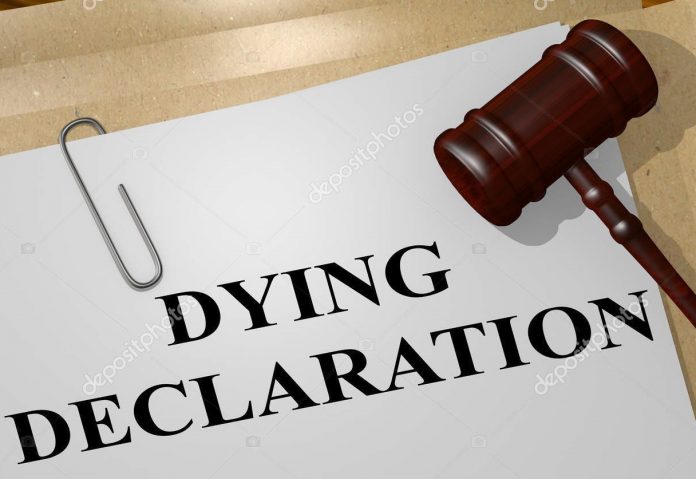This article has been written by Prathiksha. M.
This article has been edited and published by Shashwat Kaushik.
Table of Contents
Introduction
“No one will accept their guilt until his or her crime is proven.”
The Indian Evidence Act serves as a fundamental framework in the Indian legal system, significantly influencing the interpretation of cases based on the evidence presented. This act plays a pivotal role in determining the credibility and admissibility of evidence, ensuring that justice is served fairly and impartially.
One of the key aspects of the Indian Evidence Act is its applicability to both criminal and civil proceedings. In criminal cases, the act provides guidelines for the collection, presentation, and evaluation of evidence to determine the guilt or innocence of the accused. It ensures that accused individuals are not unjustly convicted based on insufficient or unreliable evidence. The act also protects the rights of victims and witnesses, safeguarding them from undue pressure or influence during the judicial process.
In civil proceedings, the Indian Evidence Act helps to establish the truth and determine the outcome of disputes between parties. It governs the admissibility of various types of evidence, such as oral testimony, documentary evidence, and expert opinions. The act aims to ensure that decisions in civil cases are based on legally admissible and reliable evidence, promoting fairness and justice for all parties involved.
Meaning
A dying declaration is a potent piece of evidence in a court of law. It is a statement made by a person who is aware that they are about to die and is made in response to questions about the circumstances surrounding their impending death. The statement must be made voluntarily and without any undue influence or coercion.
To be admissible as evidence, a dying declaration must meet several requirements:
- Competency of the declarant: The person making the statement must be competent to testify in court. This means that they must have the mental capacity to understand the nature and consequences of their statement and be able to communicate their thoughts clearly.
- Imminence of death: The declarant must be aware that they are about to die. This can be inferred from the circumstances surrounding their statement, such as their physical condition or statements made by medical professionals.
- Voluntariness: The statement must be made freely and voluntarily. It cannot be coerced or obtained through threats, promises, or other improper inducements.
- Content of the statement: The statement must relate to the cause or circumstances of the declarant’s death. It can include information about the identity of the perpetrator, the events leading up to the death, and any other relevant details.
- Consistency: The statement must be consistent with other evidence in the case. If there are significant inconsistencies, the court may question the reliability of the declaration.
Dying declarations are considered reliable because they are made under the solemn realisation of impending death. However, their weight and credibility are ultimately determined by the court based on the specific circumstances of each case.
When a person makes a dying declaration, it is important to document it properly. This can be done by recording the statement in writing, audio, or video. The person making the statement should be given the opportunity to review and correct any errors before signing or acknowledging the document. Witnesses should also be present to attest to the voluntariness and authenticity of the declaration.
Dying declarations play a vital role in ensuring that justice is served in cases involving sudden or unexplained deaths. They provide valuable evidence that can help identify perpetrators and reconstruct the events leading up to the death.

Legal maxim
“Nemo Moriturus Praesumitur Mentire” means a man will not meet his maker with a lie in his mouth. The court has a psychological belief that no person will lie on the deathbed.
Admissibility of a dying declaration:
- The statement given by the person should be related to the circumstances.
- The death of that person must be ensured.
- The declaration given by him must be with free consent, it should not be given under the influence.
- The person who is giving a declaration should be sound-minded.
- The cause of the person’s death must be in question.
- A declaration can be given in any language.
How are the dying declarations made
There is no specific type to give a declaration; it is completely dependent upon the situation and capability of the person.
Oral declaration
Oral declaration is one of the most common declarations; the victim will narrate the whole story to the authority or declaration given by the witness.
Gestures
A declaration can also be made through gestures when the person is not capable of speaking. In the case of Queen Empress vs. Abdullah, the victim’s throat was cut by the accused and she wasn’t able to speak. Therefore, she used gestures to convey the name of the accused.
Question and answer
The person who is recording the DD will ask questions to the declarant and record the answer given to him. It is one of the simplest and most effective ways to give a dying declaration.
F.I.R as a dying declaration
When a person dies after lodging an FIR to the police station, stating that his life is in danger, such an FIR can be considered a dying declaration.
For example, Mr. A got continuous death threats from Mr. B. Therefore, Mr. A lodged an F.I.R. at the nearby police station, and the next day Mr. A was found dead. In this circumstance, the FIR lodged by Mr. A can be considered a dying declaration.
Doctors’ role
Doctors play a crucial role when a person is giving a declaration. They should provide a certificate that the person is sound-minded and capable enough to give a declaration. Doctors can also record a dying declaration when they know that the person cannot survive for a long time, this happens mostly when the person is admitted with a charred body. The testimony given by the doctors will be considered, as the court believes there is nothing for a doctor to give a false statement.
Who can record a dying declaration
A dying declaration is a statement made by a person who is about to die and is believed to be true because of the person’s impending death. The purpose of a dying declaration is to provide evidence in a court of law about the circumstances surrounding a person’s death.
Several people can record a dying declaration, including:

- Magistrates:
Magistrates are judicial officers authorised to take dying declarations. Their presence adds weight and credibility to the statement, as they are impartial and have the authority to administer oaths. - Police officers:
Police officers are often the first to arrive at the scene of a crime or accident and may encounter individuals who are near death. In these cases, police officers can record the dying declarations of the victims to gather information about the incident. - Doctors:
Doctors, especially those attending to critically injured patients, may be present when a dying declaration is made. They have the medical expertise to assess the patient’s condition and ensure that the statement is made while the person is still conscious and of sound mind. - Ordinary citizens:
In situations where there is no time to wait for a magistrate or other authority figure to arrive, any ordinary citizen who is present can record a dying declaration. The witness should ensure that the declarant is lucid and understands the seriousness of the situation before taking the statement.
It’s important to note that the admissibility of a dying declaration in court depends on various factors, such as the declarant’s mental state at the time the statement was made, the consistency of the statement, and the circumstances surrounding the declaration. The court will evaluate the dying declaration along with other evidence to determine its credibility and weight.
Dying deposition
Dying deposition is quite similar to dying declaration. A dying declaration can be recorded by any normal person, police officer, doctor, or magistrate. Still, in the case of a dying deposition, the declaration given by the injured person will be recorded by the magistrate in the presence of the accused lawyer.
When death doesn’t take place
If the person didn’t die after giving a declaration, then such declaration given by him will not be considered as a dying declaration. However, a trial will take place for the statement given by him. Section 21 of the Bharatiya Sakshya Act a proof of admission against the person making them, by or on their behalf (state of mind and body), Section 137 of the Bharatiya Sakshya Act for examination in chief (to corroborate the evidence), Section 145 of the Bharatiya Sakshya Act for cross-examination as to previous statements in writings, Section 159 of the Bharatiya Sakshya Act for impeaching credit of witness, Section 159 of the Bharatiya Sakshya Act for refreshing memory and Section 164 of CrPC for recording of confession and statement will take place.
Difference between dying declaration and dying deposition
Dying declaration
A dying declaration is a statement made by a person who is believed to be dying and who has given up all hope of recovery. This statement is typically made in response to questions from a law enforcement officer, medical professional, or other authority figure. A dying declaration is considered admissible as evidence in court under the hearsay exception. This exception allows for the admission of out-of-court statements when the declarant is unavailable to testify at trial. Dying declaration and dying deposition are two distinct legal concepts that are often confused with each other. While both involve statements made by a person who is believed to be dying, there are several key differences between the two.

In order for a dying declaration to be admissible, the following conditions must be met:
- The declarant must be in imminent danger of death.
- The declarant must have given up all hope of recovery.
- The statement must be made under oath or affirmation.
- The statement must be made voluntarily and without coercion.
Dying deposition
A dying deposition is a statement made by a person who is believed to be dying, but who still has some hope of recovery. This statement is typically taken by a court reporter or other court official. A dying deposition is not admissible as evidence in court under the hearsay exception. However, it may be used to corroborate or impeach the testimony of a witness who is present at trial.
In order for a dying deposition to be taken, the following conditions must be met:
- The declarant must be in imminent danger of death.
- The declarant must have some hope of recovery.
- The statement must be made under oath or affirmation.
- The statement must be made voluntarily and without coercion.
- The court must find that the deposition is necessary to preserve the testimony of the declarant.
Comparison of dying declaration and dying deposition
The following table compares and contrasts dying declarations and dying depositions:
| Feature | Dying declaration | Dying deposition |
| Admissibility | Admissible as evidence in court. | Not admissible as evidence in court. |
| Purpose | To provide evidence of a crime. | To preserve the testimony of a witness. |
| Timing | Made when the declarant is in imminent danger of death and has given up all hope of recovery. | Made when the declarant is in imminent danger of death but still has some hope of recovery. |
| Presence of authority figure | Typically made in response to questions from a law enforcement officer, medical professional, or other authority figure. | Typically taken by a court reporter or other court official. |
| Voluntariness | Must be made voluntarily and without coercion. | Must be made voluntarily and without coercion. |
Case analysis
Kushal Rao vs. State of Bombay
In this case, 5 members joined together and attacked Baboolal. He was admitted to the hospital, and the doctors examined him and found his body was injured, the doctor asked him what had happened, and Baboolal said that he had been assaulted by Thukaram and Kushal. The doctor noted down everything on paper, and informed the police station regarding the issue. Once the police officer arrived, considering the fact that Baboolal could not survive for long, the dying declaration was recorded by the police officer and later by the magistrate after the doctor gave a certificate that he was mentally fit. The very next morning Baboolal passed away. The Apex Court dismissed the case stating that Baboolal dying declaration was sufficient enough to sustain the appellant’s conviction for murder.
Delhi Administration vs. Laxman Kumar and others
In this case, Laxman’s wife Sudha was set on fire by her husband and mother-in-law. This case was heard by the trial court; the neighbours were presented in court as witnesses. They stated that they heard Sudha’s scream and hurried to her flat and found her sari was burning in fire. They tried to help her by covering her in a thick blanket. When they asked her what had happened, she said that her mother-in-law poured kerosene, and her husband lit the fire, later she died in the hospital. After hearing the arguments from both sides, the trial court sentenced her husband, mother-in-law and brother-in-law to death. The accused went to the high court for appeal, and the Hon’ble Judges declared that Sudha’s death was an accident. Therefore all three of them were acquitted. A second appeal was made before the Supreme Court against the acquittal of the accused. The Supreme Court declared that it was not an accident; however, Sudha’s brother-in-law was acquitted as there was no proper evidence against him. The husband and mother-in-law were sentenced to life.
Pakala Narayana swami vs. Emperor
In this case, the accused wife took a loan of Rs 3000 with 18% interest from the deceased. On 20th March 1937, the lady sent a letter to the deceased asking him to come and collect the due amount. The deceased informed his wife that he was going to the lady’s house to collect the amount. On 23rd March 1937, a dead body was found in the trunk; the body was sent to a postmortem, and the reports are evident that it was an actual murder. The wife of the deceased recognised that it was her husband’s body. The court convicted the lady’s husband of murdering the deceased, not only based on the deceased wife’s declaration or the letter but also on proper evidence against the accused for murder.

Paniben vs. State of Gujarat
In this case, Bai Kanta had frequent quarrels with her mother-in-law. On the 7th of May, Bai Kanta was sleeping in the ‘or’ alone. Her mother-in-law took the chance and poured kerosene on her and lit the fire. Bai Kanta shouted for help; hearing the screaming sound, her husband and neighbours went to the place and extinguished the fire. Bai Kanta was immediately admitted to the hospital, and the matter was informed to the nearby police station. The head constable asked her what happened and she said that her mother-in-law burnt her, and the same was recorded. Another statement was recorded by the executive magistrate and the same was said to them. This case came before the Hon’ble sessions court it was said that Bai Kanta might have committed suicide and the accused was acquitted. The first appeal was made before the high court challenging the order passed by the session court; the high court judges held that it was a murder and not a suicide; therefore, the acquittal was set aside. The accused was convicted under Section 302 of the Indian Penal Code.
Nirbhaya rape case
In this case, Nirbhaya and her friend were travelling on a bus along with a gang of six, which included a minor. The bus driver started to drive the bus in a different direction, and the bus window was shut down by the gang. The friend of Nirbhaya raised the obligation, and she was knocked down by the gang. The gang raped her brutally on the running bus for hours and threw her and her friend’s bodies. A passerby person found them and informed the police station. Both of them were taken to the hospital. The doctors examined Nirbaya’s body and found her intestine was completely damaged and also found rust particles in her vagina. Three dying declarations were given, one to the doctor, one to the sub-divisional magistrate and another one to the metropolitan magistrate. The minor was sent to juvenile court and he was sentenced to imprisonment for 3 years. The driver attempted suicide in Tihar jail during the trial and the other 4 members were sentenced to death.
Conclusion
A dying declaration is a statement given by the person on the deathbed regarding the cause of action. Dying declaration should be recorded carefully considering the fact it acts as evidence in the court. The court may not consider if the DD is incomplete, forced, or threatened. A dying declaration plays a vital role in the evidence act, as the conviction will be made without corroboration.
References
- https://districts.ecourts.gov.in/sites/default/files/GAnusha%20Prl%20JCJ%20Husnabad.pdf
- https://www.advocatekhoj.com/library/lawreports/evidenceact1872/209.php?Title=Review%20of%20the%20Indian%20Evidence%20Act,%201872&STitle=Section%2021
- https://lawbhoomi.com/evidentiary-value-of-a-dying-declaration/
- https://www.drishtijudiciary.com/to-the-point/ttp-indian-evidence-act/dying-declaration
 Serato DJ Crack 2025Serato DJ PRO Crack
Serato DJ Crack 2025Serato DJ PRO Crack










 Allow notifications
Allow notifications



